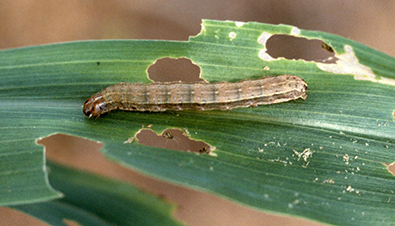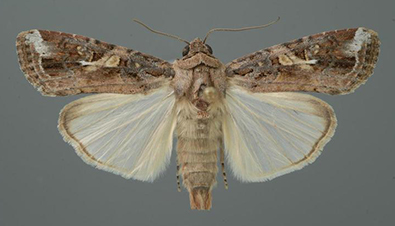Read the latest information on
Foot-and-mouth disease

Image: John C. French Sr., Retired, Universities:Auburn, GA, Clemson and U of MO, Bugwood.org
The exotic pest fall armyworm (Spodoptera frugiperda) has been detected in Australia, on islands in the Torres Strait, Bamaga in Cape York, at Croyden in the Gulf country, South Johnstone, Tolga and Lakeland in Queensland.
In the weeks since it was first found, it has also been found in Bowen and the Burdekin region south of Townsville.
Even though it’s new to Australia, the recommendation of the Consultative Committee on Emergency Plant Pests to the National Management Group* is that it is not technically feasible to eradicate fall armyworm. That’s not surprising, since not one of the 65 countries it has invaded has been able to eradicate this pest. This is due to the pest’s reproductive capacity, ability to fly long distances and its wide host range, combined with the remoteness and spread of known infestations.
Fall armyworm larvae are known to feed on more than 350 plant species, particularly maize, cotton, rice, sorghum, sugarcane and wheat, but also many vegetable and fruit crops causing significant economic losses overseas. A wide range of growers (represented by 11 industry bodies), particularly in the north of Australia, could be affected by this pest.
In the absence of control measures, destruction of crops such as maize and rice can happen almost overnight in some countries, when population levels are high.
The Australian Government, state and territory governments, industry groups and communities are working to assess the distribution, host range and threat of the pest and to plan and prepare industries for ongoing management of the pest. A series of grower forums and management guides are currently being developed to deliver the latest knowledge on the monitoring for and management of FAW across our northern farming systems.

Image: Lyle Buss, University of Florida, Bugwood.org
Fall armyworm is native to tropical and subtropical regions of the Americas. Since 2016 it has rapidly spread to and throughout Africa, India, China and south-east Asia.
The larvae are most active during late summer and early autumn months. Adult moths can fly long distances and their migration rate is remarkably fast. As well as natural dispersal, they can also be spread through movement of people.
The conditions in northern Australia, including climate and access to suitable hosts, are favourable for this pest to establish and spread. It is most likely found in warm, moist regions with little forest cover or hitchhiking on fresh vegetables or fruit.
There are other types of Spodoptera already present in Australia, such as lawn armyworm and day feeding armyworm, which can look similar to fall armyworm.
See Further Information section below for more about what the pest looks like.
 Formal surveillance, including trapping, will continue in major agricultural areas across Queensland, Northern Territory and Western Australia to monitor for the pest. This will help to provide advice to growers about its presence and potential threat.
Formal surveillance, including trapping, will continue in major agricultural areas across Queensland, Northern Territory and Western Australia to monitor for the pest. This will help to provide advice to growers about its presence and potential threat.
Growers too are asked to keep an eye out for unusual damage to crops and call the plant pest hotline 1800 084 881 to get in touch with their state department of agriculture.
Fall armyworm larvae initially feed on leaves, creating pinholes and windows in leaf tissue, and giving leaf margins a tattered appearance. Larvae can also eat buds and tunnel into and feed on fruit.
Appropriate registered pesticides may be suitable to treat fall armyworm infestations, if used in accordance with label instructions and state or territory government controls. (See Further Information section below for an example.)
Growers can also remove alternative host plants around paddocks or fields that can harbour the pest.
*A word about Australia’s plant pest response arrangements
The Consultative Committee on Emergency Plant Pests provides technical and scientific advice in response to exotic plant pest and disease outbreaks. The Committee is chaired by Australia’s Chief Plant Protection Officer and comprises the Chief Plant Health Managers from each state and territory, other specialists from government, Plant Health Australia, and representatives from industries that are potentially affected by the plant pest being considered – in this instance, 11 – that are signatories to the Emergency Plant Pest Response Deed.
The National Management Group (NMG) comprises Chief Executive Officers from government agencies responsible for agriculture, and affected industry organisations that are signatories to the Emergency Plant Pest Response Deed. It is chaired by the Secretary of the Australian Government Department of Agriculture. Plant Health Australia is a non-voting member.
NMG makes decisions on whether or not to support national eradication programs for pest or disease outbreaks under the Emergency Plant Pest Response Deed. NMG considers recommendations provided by the consultative committee before making decisions on whether or not a pest or disease is technically feasible and cost-beneficial to eradicate.
The Emergency Plant Pest Response Deed is a formal legally binding agreement between Plant Health Australia, the Australian, state and territory governments, and national plant industry bodies representing specific cropping sectors. The Deed covers the management and funding of nationally agreed responses to emergency plant pests.